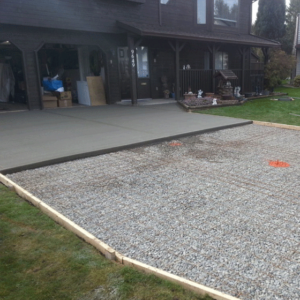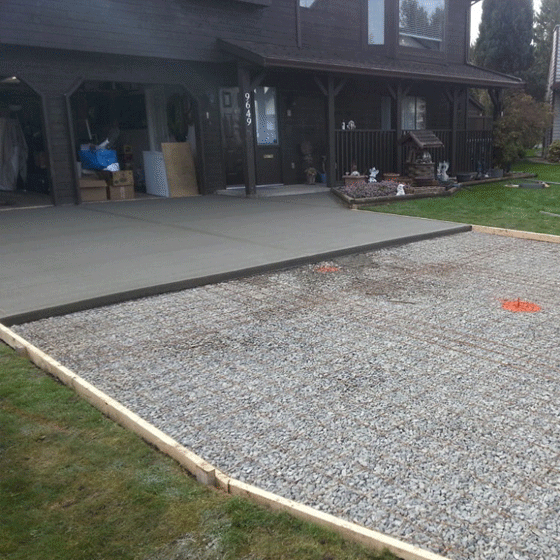A new driveway is a major investment. Whether it’s made of concrete or asphalt, the driveway serves as the first impression for guests and visitors to your home.
Eventually, most driveways will need to be replaced. It’s important to know when the time is right and how to plan for it. Consult the experts at Driveway Replacement Colorado Springs.
Cracks and potholes are not only unsightly, but they also allow water to seep into the subsoil base of your driveway, causing damage. It is important to address these issues as soon as possible so that the problem doesn’t worsen over time. Depending on the extent of the damage, there are several options for repair.
A crack sealer is an inexpensive and quick solution for smaller cracks. It can help extend the life of your driveway for two to three years, as long as it is properly applied and maintained. Hose down the area to be repaired and allow it to completely dry before applying the crack filler. It’s best to apply this type of crack repair before the temperature starts dropping. Cold weather can cause asphalt to contract and enlarge the cracks.
If you’re experiencing major cracking or heaving in your driveway, it may be time to call a professional paving contractor. If these problems aren’t addressed, they can lead to a collapsed or unusable driveway.
Heaving and cracking can be caused by many factors, including poor soil preparation or drainage. This is why it’s so important to hire a professional with experience installing and repairing asphalt driveways. Ask to see examples of their work from neighbors and friends who have had similar paving done.
A large crack in the pavement can lead to a pothole, which is a safety hazard for drivers and pedestrians alike. They are caused by water that has infiltrated through cracks and soaked into the asphalt and gravel subbase, then freezes and expands with the weather. Over time, this destabilizes the pavement and causes it to sink into a hole.
Potholes can be repaired by filling them with hot or cold-pour rubberized crackfill. However, if the cracks are wider than 1/2-inch, resurfacing or lifting the driveway is a better option for long-term repairs. A resurfacing job will cost more than patching, but it will add years to the life of your driveway. The most durable option is to replace your driveway, but even that requires proper installation and maintenance.
Damage to the Subsoil Base
Concrete driveways are fairly sturdy, but they can be damaged by frost and ground shifting. Cracks in concrete can let in water that erodes the subbase and freezes, making the problem worse. Often, the only solution is to replace the driveway entirely.
The same holds true for asphalt. It’s cheaper to repair cracks and patch holes than to replace the entire surface, but homeowners shouldn’t ignore damage or assume that it won’t get worse. Small, solitary cracks may not seem to require repair, but these fissures can spread rapidly and lead to potholes.
Alligator cracks—interconnected cracks that resemble reptile scales—may also indicate a more serious problem beneath the surface. Unless the cracks are insignificant, a homeowner should consider replacing the asphalt rather than simply filling them with sealant.
If a concrete driveway has major spalling, it isn’t safe to drive on. Disintegrating concrete is unsightly, and it can weaken the structural integrity of the driveway, which could collapse under the weight of vehicles or other forces.
Concrete driveways can be repaired by grinding the old concrete and applying a thick layer of new concrete over it. The concrete can be stained and textured to hide flaws, and there are many options for patterning and color.
If the existing driveway has minor settling, contractors can use slab jacking to raise the concrete back to its original position. This process involves pumping a mixture of cement, sand, and fly ash underneath the concrete to raise it.
If the existing concrete is heaving, it means that the soil under the driveway has shifted or eroded. This can cause one section of the driveway to rise up over another at a seam or crack. This can be caused by a variety of issues, including improper drainage design and the presence of tree roots. In some cases, regrading the driveway can help, but in other situations, it’s necessary to replace the driveway altogether. A new concrete driveway will better direct water away from homes, preventing foundation problems. It will also restart the lifespan clock for the driveway, reducing future repairs.
Severely cracked driveways
While some hairline cracks in concrete driveways are to be expected, severe cracks can detract from curb appeal and may be a sign of larger problems. It’s important to get these repaired promptly and correctly. The right repair solution can save you money in the long run and prevent further damage. Whether you need a do-it-yourself repair or professional assistance, a quick estimate from a local contractor can help you decide the best way to proceed.
A concrete contractor can offer a number of solutions, from simple color enhancements to complete resurfacing or replacement. In some cases, a repair can be done on-site using a product such as Quikrete’s Concrete Resurfacing Mix and Concrete Overlay that can be applied to the existing surface to create a fresh new look for the whole driveway. In other cases, a professional will need to jack the driveway up and remove it for reconstruction.
Cracks in concrete driveways can occur from many sources, both during construction and over time. Some can be caused by the initial pour, while others may result from settling and heavy traffic. In any event, these are signs that the structural integrity of the driveway is deteriorating and should be investigated by a professional to see if there are underlying issues that require more extensive repair or replacement.
Small cracks less than 1/2 inch wide can be filled with a concrete or asphalt crack filler. These are usually available in no-mess cartridges for a caulking gun or in pourable squeeze bottles. To prepare the area, chisel away any loose material and clean the crack of any debris or weed growth. Crack fillers with a self-leveling capability that is flexible to accommodate slight changes in temperature are recommended.
More significant cracks, sometimes called “alligator skin” because of their appearance, can be repaired with a concrete patching compound. This type of compound contains a plasticizer that allows it to stretch as the concrete expands and contracts, helping it bond and remain in place. Once it is pressed into the crack and smoothed with a putty knife, the cracks should be covered with a high-quality sealer to protect against weather and other elements.
Curb Appeal
A pristine driveway is one of the first things potential buyers see, and it’s a strong indicator that the home they are touring will be well maintained. However, a cracked, crumbling, or otherwise damaged front walkway and driveway can be a huge turnoff. Updating these areas is the quickest and easiest way to boost your curb appeal without spending the money it takes to completely overhaul your whole exterior.
When it comes to replacing your driveway, there are a few different options you can choose from, including resurfacing and complete replacement. Resurfacing involves removing the old surface and applying a new layer, which can include filler or sealer to repair small cracks and holes. It’s often a good choice if you’re in the market for an affordable upgrade since asphalt and concrete are prone to cracking over time.
Choosing the right driveway material is also important. Both Micetich and Harmon agree that it is best to work with a professional who uses high-quality materials, so you can expect your driveway to last longer. A contractor who is using subpar materials will most likely cut corners, and you’ll end up with a surface that deteriorates much faster than it should.
If you choose to go with concrete, consider adding a decorative element to it to increase its curb appeal. For example, you can add a stenciled pattern or choose to stain it a unique color. You can even opt for a more modern look with resin-bound surfacing, which is a coating that uses a mix of resin and aggregate stone to create your ideal design.
For homeowners who want to take their curb appeal game up a notch, lighting is a great option. “Lighting to me is drama; it’s the jewelry on a house,” Fleming says. Strategically placed solar lights can be used to highlight the shape and texture of a concrete driveway. You can also hang string lights along the edge of your walkway to illuminate the pathway and set a welcoming tone for visitors.
Your driveway and front walk are more than just a path from the street to your door. They’re the first impression a visitor has of your home, and it’s important that they leave a positive one. Replacing or repairing your driveway will give you and future visitors the peace of mind that it will be safe to park on and enjoy this important outdoor space.

